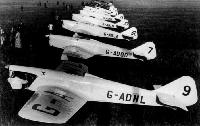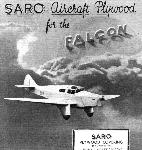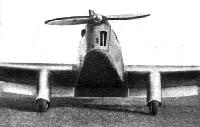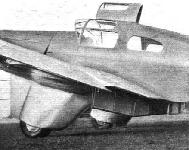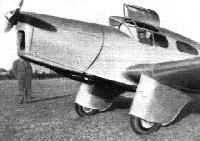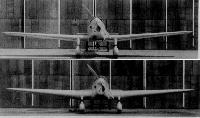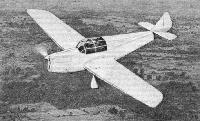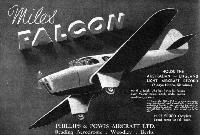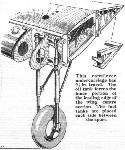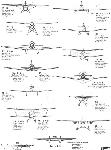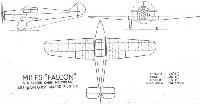
Варианты
- Miles - Falcon M.3 / Hawcon M.6 - 1934 - Великобритания
- Miles - Merlin / M.4 - 1935 - Великобритания
- Miles - Nighthawk M.7 / Mentor M.16 - 1935 - Великобритания
Miles M.3 Falcon
Прототип первого настоящего кабинного моноплана M.3 Falcon, спроектированного Ф. Г. Майлзом, выполнил первый полет 12 октября 1934 года. Прототип был трехместным, но в более широкой кабине первой серийной машины помещалось четыре человека. Всего построили 36 самолетов нескольких вариантов, включая M.3A Falcon Major и M.3B Falcon Six. Шесть машин накануне Второй мировой войны поступили в британские ВВС.
Описание:
- Miles M.3 Falcon
- M.6 Hawcon
- Flight, August 1934
NEW CABIN MONOPLANE - Flight, January 1935
IMPROVEMENTS in the "FALCON" - Flight, February 1935
FLYING COMFORT - Flight, April 1936
MODERN LIGHT AIRCRAFT REVIEWED
Фотографии
-
Aeroplane Monthly 1991-07 / Miles M.3A Falcon Major G-AEEG /Preservation Profile/
Регистрационный номер: G-AEEG [13], SE-AFN [13] NORMAN RIVETT's colour photograph was taken on March 9, 1971; the pilot of the Falcon Major was Dr Ian Dalziel.
-
Aeroplane Monthly 1993-10 / M.Oakey - Grapevine
Регистрационный номер: G-AEEG [13], SE-AFN [13] Skysport Engineering’s recently-restored Miles Falcon G-AEEG in new colours over the Old Warden area on August 20, 1993.
-
Мировая Авиация 139
Регистрационный номер: G-AEEG [13], SE-AFN [13] "Miles" являлась одним из основных производителей легких самолетов в межвоенный период, но лишь немногие ее самолеты отличала присущая M.3A Falcon элегантность.
-
Aeroplane Monthly 1998-12 / M.Oakey, T.Harmsworth - News
Регистрационный номер: EC-ACB [3], G-ADLS [3] Miles Falcon Six EC-ACB (ex G-ADLS) of the Fundacion Infante de Orleans is took to the air during the group's display at Cuatro Vientos, Madrid, on September 6, 1998. Displays are held on the first Sunday of each month during the summer. A recent addition to the fleet is Comper Swift G-ABUU, which will commemorate the Swift flown by Spanish pilot Rein Loring to the Philippines in 1932.
-
Flight 1934-10 / Flight
SOMETHING NEW: The first Miles "Falcon" (D.H. "Gipsy Major") which will be flown by Mr. H. L. Brook
-
Flight 1934-10 / Flight
Регистрационный номер: G-ACTM [3] STRAIGHT FROM THE SHOP: The Miles "Falcon" was only delivered to Mr. H. L. Brook on Saturday. Note the position of the extra tank filler cap.
-
Aeroplane Monthly 1991-03 / M.Fife - The Great Air Race
Регистрационный номер: G-ACTM [3], VH-AAT [2] Col Keith Hatfield's Miles Falcon VH-AAT was used to portray Falcon G-ACTM flown by H. L. Brook with fare-paying Miss E. Lay as passenger. The fourth and last aircraft to leave Mildenhall, G-ACTM took a month to reach Melbourne, arriving there on November 2, 1934.
-
Aeroplane Monthly 1991-03 / M.Fife - The Great Air Race
Регистрационный номер: G-ACTM [3], VH-AAT [2] The start at Mildenhall, actually RAAF Laverton. From left to right. Comet replica “G-ACSP", Bruce Dwyer's Stearman (representing Fairey Fox G-ACXO), “DC-2" PH-AJU, Comet replica “G-ACSS" and Miles Falcon “G-ACTM".
Другие самолёты на фотографии: De Havilland Comet / D.H.88 - Великобритания - 1934Douglas DC-3 / C-47 Skytrain/С-53 Skytrooper / Dakota - США - 1935Stearman PT-13 / PT-17 Kaydet / Model 73 (Boeing-Stearman) - США - 1934
-
Aviation Historian 29 / M.Bearman - Going with the Flow?
Регистрационный номер: K5924 Seen here before its laminar-flow modifications, Miles M.3B Falcon Six Special K5924 (c/n 252) was much used by the RAE as a wing testbed from early 1936. It was re-delivered to Farnborough circa March 1940 with a 60 per cent laminar-flow aerofoil profile (i.e. maximum thickness at 60 per cent of chord) for testing during 1940-41.
-
Flight 1935-08 / Flight
This Miles "Falcon," with tandem seating, has been entered for the King's Cup by Viscountess Wakefield, and will be flown by Flt. Lt. "Tommy" Rose.
-
Flight 1935-02 / Flight
Регистрационный номер: G-ADBF -
Flight 1935-04 / Flight
Регистрационный номер: G-ADER [2] One of the first batch of production-model Miles "Falcons," taken last week-end by a Flight photographer over Reading Aerodrome, where the makers' works are situated, and which is the home of the Reading Aero Club. The engine of the "Falcon" is a 130 h.p. "Gipsy Major" and the cabin seats three passengers and a pilot in comfort.
-
Flight 1935-06 / Flight Advertisements
Регистрационный номер: G-ADER [2] -
Flight 1936-04 / Flight
Регистрационный номер: G-ADLC [13] The Falcon Six - actually the King's Cup winner being flown by Flt. Lt. Rose himself.
-
Flight 1936-02 / Flight
Регистрационный номер: G-ADLC [13] ODYSSEY, 1936: The Miles Falcon (Gipsy Six) in which Flt. Lt. T. Rose handsomely lowered the England-Cape record; this Flight photograph was taken during a final test on the day before the successful attempt started.
-
Flight 1936-01 / Flight Advertisements
Регистрационный номер: G-ADLC [13] FALCON SIX Gipsy VI Engine WINNER OF KING'S CUP AIR RACE, 1935 Price ?1,485 ex Works. Maximum Speed 180 m.p.h. Cruising Speed 160 m.p.h. Landing Speed 40-45 m.p.h. Landing run with brakes and flaps 130 yards. Rate of climb 1,125 feet/min. Petrol consumption 10 galls./hr. Range 560 miles (with enlarged tank 880 miles). Beautifully furnished cabin with side by side seating of ample dimensions for two passengers.
-
Flight 1937-09 / Flight
Регистрационный номер: G-ADLC [13] -
Flight 1936-07 / Flight
Регистрационный номер: G-ADLC [13] Types of competing machines: Miles Falcon
-
Flight 1935-12 / Flight
Регистрационный номер: G-ADLC [13] Two high-speed low-wing monoplanes, the Miles Falcon Six and the Airspeed Courier.
Другие самолёты на фотографии: Airspeed Courier / AS.5 - Великобритания - 1933
-
Flight 1935-09 / Flight
Регистрационный номер: G-ADLC [13] "Leading-in the winner" of the King's Cup is as much a rite as leading in the winner of the Derby.
-
Aeroplane Monthly 1988-08 / A.Henshaw - Miles for the Cup! (2)
Регистрационный номер: G-ADLC [13] The victorious Rose taxies the Miles Falcon G-ADLC in after winning.
-
Aeroplane Monthly 1988-08 / A.Henshaw - Miles for the Cup! (2)
Регистрационный номер: G-ADLC [13] PREPAREDNESS REWARDED: All the eleven Miles Hawks and the two Miles Falcons lined up for inspection by a large number of guests on the day before the King's Cup entries were due at Hatfield for presentation before the scrutineers. The firm will probably go down in history as the first to be completely ready for the race, and their preparedness was certainly rewarded with four machines in the first five of the final. It was extraordinary that all the machines could have been brought for the presentation as many of them had already been delivered. During the afternoon Mr. Miles demonstrated the manoeuvrability of the New Hawk M.5. with a display of superbly executed aerobatics.
An impressive line-up of Miles participants, photographed at Hatfield on the day before the race. The line-up was made up of Miles Hawks and two Falcons.Другие самолёты на фотографии: Miles Hawk / M.2 - Великобритания - 1932Miles Sparrowhawk / M.5 - Великобритания - 1935
-
Мировая Авиация 194
Регистрационный номер: G-ADLC [13] M.5 Sparrowhawk отличался элегантным обликом. Прототип G-ADNL получил приз за скорость в гонках на Королевский кубок 1935 года.
Другие самолёты на фотографии: Miles Hawk / M.2 - Великобритания - 1932Miles Sparrowhawk / M.5 - Великобритания - 1935
-
Aeroplane Monthly 1988-07 / A.Henshaw - Miles for the Cup! (1)
Регистрационный номер: G-ADLC [13] All pictures of the Sparrowhawk G-ADNL bearing the race number 9 were taken at the time of the aircraft's participation in the 1935 King's Cup air race. This photograph was taken shortly before the start of that race, at Hatfield on September 6. The other Miles types on the line include the Miles Hawk Majors G-ADOD, G-ADNK and G-ADLB, Miles Hawk Trainer G-ADLN and the Miles Falcon Six G-ADLC.
(Hawk Speed Six G-ADOD, Hawk Trainers G-ADLB and G-ADLN, Hawk de Luxe G-ADNK and Falcon G-ADLC)Другие самолёты на фотографии: Miles Hawk / M.2 - Великобритания - 1932Miles Sparrowhawk / M.5 - Великобритания - 1935
-
Aeroplane Monthly 1991-06 / J.Havers - Field of endeavour (2)
Регистрационный номер: G-ADLI [2] Brian Field’s Miles Falcon G-ADLI, acquired in August 1939. Following several post-war ownerships, this Falcon crashed at Elstree on September 10, 1952.
Miles M.3A Falcon Major G-ADLI visited the Redhill airfield in October 1950. -
Aeroplane Monthly 1989-03 / Personal album. Civil
Регистрационный номер: G-ADLI [2] Miles M.3A Falcon Major G-ADLI was built in 1935. After several pre-war owners the Falcon survived the war but was destroyed at Elstree on September 10, 1952.
-
Мировая Авиация 194
Регистрационный номер: G-AEEG [13], SE-AFN [13] На M.3 Falcon стоял мотор de Havilland Gipsy Six мощностью 200 л. с. Размах крыла самолета составлял 10,67 м, максимальная скорость - 290 км/ч, нормальная дальность полета - 900 км.
-
Aeroplane Monthly 1977-08 / ??? - Vintage Falcon
Регистрационный номер: G-AEEG [13], SE-AFN [13] -
Aeroplane Monthly 1977-08 / ??? - Vintage Falcon
Регистрационный номер: G-AEEG [13], SE-AFN [13] The picture was taken by N. B. RIVETT, portray the clean lines of the Hawk Major, enhanced by the neat undercarriage trouser fairings. The raked windscreen which was introduced on the Falcon became a "trademark" on subsequent Miles designs.
-
Aeroplane Monthly 1977-08 / ??? - Vintage Falcon
Регистрационный номер: G-AEEG [13], SE-AFN [13] -
Aeroplane Monthly 1991-07 / Miles M.3A Falcon Major G-AEEG /Preservation Profile/
Регистрационный номер: G-AEEG [13], SE-AFN [13] G-AEEG landing at Old Warden with owner/pilot Edward Eves at the controls.
-
Aeroplane Monthly 1991-07 / Miles M.3A Falcon Major G-AEEG /Preservation Profile/
Регистрационный номер: G-AEEG [13], SE-AFN [13] These two photographs of Falcon Major G-AEEG were taken in 1936, when it was painted in an overall silver colour scheme.
-
Flight 1935-09 / Flight
Регистрационный номер: I-ZENA AN INTERNATIONAL AFFAIR: The scene at Littorio (Rome) Aerodrome, Italy, at the start of the recent International meeting for a flight round Italy. The first lap was to Naples. A Miles Falcon is in the foreground.
-
Aeroplane Monthly 1991-07 / Miles M.3A Falcon Major G-AEEG /Preservation Profile/
Регистрационный номер: SE-AFN [13], G-AEEG [13] Falcon Major G-AEEG as SE-AFN, photographed in Sweden.
-
Flight 1935-05 / Flight Advertisements
H. L BROOK FLYING A STANDARD MILES FALCON (GIPSY MAJOR) Accomplished the amazing performance by flying from AUSTRALIA to ENGLAND in 7 DAYS 19 hours 50 mins.
-
Flight 1935-09 / Flight
Регистрационный номер: G-ADLC [13] The victorious Miles Falcon (Gipsy Six) snapped as it swooped across the line, winner of the final at 176.28 m.p.h.
-
Flight 1935-04 / Flight
Genesis: This photograph, taken by a Flight photographer from a standard "Hawk" (Cirrus III), shows the "Hawk Major" (Gipsy Major), the "Falcon" (Gipsy Major) and, at the top, the "Merlin" (Gipsy Six).
Другие самолёты на фотографии: Miles Hawk / M.2 - Великобритания - 1932Miles Merlin / M.4 - Великобритания - 1935
-
Aeroplane Monthly 1988-11 / A.Lumsden, T.Heffernan - Per Mare Probare (11)
UP WITH THE COMPOSITE: Though the first separation of the Short-Mayo composite combination, Mercury and Maia, is said to have been witnessed only by bargees in the Medway estuary, the art of the aerial photographer brings us an intimate glimpse of this strangest of all aircraft not long before the “great event.”
It is said that the first separation of the Short-Mayo composite combination, Mercury and Maia, was witnessed only by bargees in the Medway estuary. The photograph was taken not long before the great event. Note the Miles camera-plane in the distance.Другие самолёты на фотографии: Short Mayo Composite (S.20 Mercury and S.21 Maia) - Великобритания - 1938
-
Flight 1935-02 / Flight
A view which gives a good idea of the area of the flaps
-
Aeroplane Monthly 1988-07 / A.Henshaw - Miles for the Cup! (1)
The Hatfield sheds filled with competitors’ aircraft, mostly Miles Hawks and Falcons.
Другие самолёты на фотографии: Miles Hawk / M.2 - Великобритания - 1932Percival Gull - Великобритания - 1932
-
Air-Britain Archive 1988-01
In response to our appeal for photos of the Municipal Aerodromes already listed David Birch sent us two shots from his collection. The air-to-ground view shows the fuel pumps, hangar and club house at Tollerton, from the east. Arranged outside are some of the local residents, comprising five Moths, one Hornet Moth, one Falcon, one Hawk, one Whitney Straight, one Swallow 2 and one Bluebird IV. The aircraft on the left appears to be the Nottingham Flying Club Moth Major G-ACZX, which enables us to date the photograph between 11.34 and 8.37.
Другие самолёты на фотографии: Blackburn Bluebird / L.1 - Великобритания - 1924British Klemm L.25 Swallow - Великобритания - 1933De Havilland Gipsy Moth / Moth X - Великобритания - 1928De Havilland Hornet Moth / D.H.87 - Великобритания - 1934De Havilland Moth Major / D.H.60GIII - Великобритания - 1932Miles Hawk / M.2 - Великобритания - 1932Miles Whitney Straight / M.11 - Великобритания - 1936
-
Aeroplane Monthly 1991-04 / M.Oakey - Grapevine
Регистрационный номер: EC-ACB [3], G-ADLS [3] One more aircraft from the Fundacion Infante de Orleans collection in Madrid. Miles Falcon EC-ACB, which served in the Spanish Civil War and flew until 1957 (not 1955 as previously reported). Since this picture was taken, EC-ACB has been dismantled for storage pending restoration. Built in 1935, it is one of just three surviving Falcons.
-
Aeroplane Monthly 1989-10 / M.Oakey - Grapevine
Регистрационный номер: G-AEEG [13], SE-AFN [13] Roger Reeves’s yellow Bucker Jungmeister G-BUKK outside Skysport Engineering’s hangar near Sandy, Bedfordshire on August 21, 1989 after an overhaul. Sky sport’s newly-acquired Miles Falcon Major G-AEEG is just visible in the hangar.
Другие самолёты на фотографии: Bucker Bu.133 Jungmeister - Германия - 1935
-
Flight 1935-04 / Flight
Mr. Brook being congratulated by Flt. Lt. "Tommy" Rose on his arrival at Lympne.
-
Flight 1935-06 / Flight
CABIN COMFORT: Signor Parodi, the pilot of a Miles "Falcon," is congratulated after winning the Raduno Sahariano in Tripoli. General Balbo, in a sun helmet, can be seen beside the engine cowling. The "Falcon" was the only English machine in the Rally.
-
Aeroplane Monthly 1988-07 / A.Henshaw - Miles for the Cup! (1)
Abyssinia? Flt Lt. Rose snapped only five minutes before the start of the Eliminating Race.
Tommy Rose doing his Francis Drake bit - nonchalently reading the News Chronicle five minutes before the race. -
Flight 1935-02 / Flight
The flaps seen from behind
-
Flight 1935-02 / Flight
The clean undercarriage and the new windscreen
-
АвиаМастер 2002-08 / М.Жирохов, И.Сеидов - Яростное небо Эускади /Из истории воздушных войн/
Еще двое "артистов цирка Кроне" - английские спортивные "Майлзы", использовавшиеся на Северном фронте в качестве легких многоцелевых боевых машин.
-
Air Pictorial 1961-10
Регистрационный номер: SE-AFN [13], G-AEEG [13] Twenty-five-year-old Miles M.3A Falcon SE-AFN, c/n. 216, ex U-20 and G-AEEG, returned to Miles at Shoreham for overhaul 23/7/61
-
Flight 1938-12 / Flight
The Irving aerodynamically balanced double flaps as experimentally fitted to a Miles Falcon. It will be seen that the balance would be neutral, with the airflow attempting to “raise” the lower half and “lower” the upper half
-
Aviation Historian 29 / M.Bearman - Going with the Flow?
Регистрационный номер: R4071 The first of the Miles light aircraft supplied to the RAE to be fitted with a "laminar flow" wing was M.3F Falcon Six R4071 (c/n 269). It is seen here sporting the Piercy-type aerofoil (with maximum thickness at 40 per cent chord) with which it was fitted during trials with spoilers (seen extended on the port wing) as a means of roll control.
-
Aviation Historian 29 / M.Bearman - Going with the Flow?
Регистрационный номер: L9705 [4] The most effective of the RAE’s Miles research aircraft in terms of laminar-flow trials was M.3E Falcon Six L9705 (c/n 289), which, when fitted with an aerofoil with its maximum thickness at 50 per cent of chord (not fitted in this photograph), was capable of maintaining attached “laminar” flow as far back as 66 per cent of chord - if the surface was perfectly smoothed.
-
Air Pictorial 1957-01 / Photos by request
Регистрационный номер: L9705 [4] "GILLETTE FALCON". This much-modified Miles M.3B Falcon Six (L9705) was converted at Woodley, Reading, in 1944 to take scaled-down, knife-edge main- and tailplanes in order to provide data for the ill-fated 1,000-m.p.h. Miles M.52 research project (Air Min. Spec. E.24/43). These new surfaces were of highly polished wood. First flight, 11/7/44. Fate unknown.
Другие самолёты на фотографии: Miles M.52 - Великобритания - 1946
-
Aviation Historian 29 / M.Bearman - Going with the Flow?
Регистрационный номер: L9705 [4] Falcon L9705 was fitted with another, far more radical, set of wings in 1944, this time intended to test prospective wing profiles for the turbojet-powered Miles M.52. These sharp, thin, bi-convex wing profiles required the undercarriage to be relocated on the “Gillette Falcon”, as it was dubbed, and were designed to combat supersonic shock, not explore laminar flow.
-
Jane's All the World Aircraft 1947 / All the world's aeroplanes
Регистрационный номер: L9705 [4] A Miles Falcon-Six Monoplane fitted experimentally with the wing of the projected M-52 jet-propelled supersonic Monoplane.
Другие самолёты на фотографии: Miles M.52 - Великобритания - 1946
-
Air International 1985-11 / B.Burns - The Laminar Airliner ... Prospects and Problems
Регистрационный номер: K5925 [5] One of the earliest full-scale experiments into boundary layer control made use of the Miles M.6 Hawcon.
-
Aviation Historian 29 / M.Bearman - Going with the Flow?
Регистрационный номер: K5925 [5] Designed specifically as a research aircraft to investigate the effects of wing thickness on drag, the sole Miles M.6 Hawcon (c/n 187) was given the serial K5925, and arrived at the RAE in Farnborough in late November 1935. The data the tests yielded were of use to Melvill Jones for his boundary-layer lecture in New York in 1937.
-
Мировая Авиация 194
Регистрационный номер: K5925 [5] M.6 Hawcon был экспериментальным самолетом, собранным из компонентов Falcon и Hawk. На M.6 испытывались крылья с толщиной профиля 15% (вверху) и 25% (внизу).
-
Flight 1935-12 / Flight
Регистрационный номер: K5925 [5] FOR HIGH-SPEED RESEARCH. The Miles Hawcon has been built specially for the Air Ministry in order to carry out high-speed research on thick wing sections. Wings of different thickness-chord ratios will be tested. The engine is a 200 h.p. Gipsy Six.
-
Flight 1936-04 / Flight
Регистрационный номер: K5925 [5] The in-line air-cooled engine permits a clean cowling installation, as typified on the Miles Hawcon (D. H. Gipsy Six) in the Flight photograph.
-
Flight 1935-04 / Flight Advertisements
SMITH INSTRUMENTS and "HUSUN" COMPASS are standard equipment on the MILES FALCON.
-
Flight 1936-04 / Flight
In its three-seater form the pilot of the Miles Falcon - in this case the Gipsy Six model - is seated centrally. As a four-seater the third passenger sits beside the pilot, who has the control column on his right. The arrangements for passengers and luggage are shown in the diagram.
-
Flight 1935-06 / Flight Advertisements
Dual control has been arranged in a neat manner which, obviates the necessity of having two control columns or the swing over type. The "Falcon" is extremely economical, 20 miles to the gallon, comparable to a light car, and with a top speed of 145 m.p.h. and cruising of 125 m.p.h. is faster than any other 3/4 seater of similar horse power. Easier to fly, quicker take-off, and lower landing speed are obtained with the hydraulically operated Miles split flaps, and with them 10% REBATE IN INSURANCE.
-
Flight 1935-06 / Flight Advertisements
The fuselage of the Miles "Falcon" is unusually wide, and comfort has been specially considered in the design of the seating accommodation. The roof, sides and floor of the cabin are doubled, and between is packed a special light soundproof material, resulting in a very high degree of sound insulation being attained. The noise of the airscrew and engine has been so reduced that passengers may converse easily and without strain. The new type windscreen prevents rain from obscuring the view and at the same time affords the occupants an extensive outlook.
-
Flight 1935-09 / Flight
A cut-away view of the cabin of the machine which, in the hands of Flt. Lt. Rose, won the King's Cup at 176.28 m.p.h. Providing comfort better than that of the majority of motor cars, the Falcon's upholstery (by Rumbold) is extremely pleasing. Among the instruments can be seen the Sestrel compass, Reid and Sigrist turn indicator, and an array of Smith's aircraft instruments. On the left of the control column is the flap-operating lever, and in front are those for brakes and tail trim.
-
Aeroplane Monthly 1993-11 / M.Oakey - Grapevine
Регистрационный номер: EC-ACB [3], G-ADLS [3] Photographed recently at Cuatro Vientos, Madrid, Fundacion Infante de Orleans Miles M.3A Falcon Major EC-ACB is now in the UK for restoration work.
-
Aeroplane Monthly 2000-08 / I.Frimston - Rare breeds at Rotary Farm /Skysport Engineering/
Регистрационный номер: G-AEEG [13], SE-AFN [13] Miles Falcon G-AEEG was restored and flown by Skysport in the 1980s.
-
Aeroplane Monthly 1991-10
Tommy Rose
-
Flight 1935-01 / Flight
Our artist's impression of the new Miles "Falcon" ("Gipsy Major"), as it will look with its redesigned windscreen.
-
Flight 1935-01 / Flight
Details of the central control box, carrying the hinged control column and the support for the two pairs of pedals. Hingeing of the column in this manner provides full aileron movement without incommoding the passengers, although the column is between them.
-
Flight 1934-08 / Flight
This cantilever undercarriage has 9 1/2 in. travel. The oil tank forms the inner portion of the leading edge of the wing centre section. The fuel tanks are placed each side between the spars
-
Flight 1935-01 / Flight
Structural details of the cabin, showing the formation of the windscreen. Part of the starboard wing flap is shown; the flaps are of the balanced type, with the centre balance portion operating forward, and thus in the opposite direction to the main flaps.
-
Flight 1934-10 / Flight
Другие самолёты на фотографии: Bellanca 28 Flash - США - 1934De Havilland Comet / D.H.88 - Великобритания - 1934De Havilland Fox Moth / D.H.83 - Великобритания - 1932De Havilland Leopard Moth / D.H.85 - Великобритания - 1933Fairey Fox - Великобритания - 1925Harkness & Hillier All Australian - Австралия - 1934Lockheed Sirius / Altair 8 - США - 1929Lockheed Vega - США - 1927Monocoupe 90 / 110 / 145 - США - 1930Northrop Delta - США - 1933Percival Gull - Великобритания - 1932Short Scion / S.16 - Великобритания - 1933
-
Flight 1933-10 / Flight
CLOSED IN: The latest and next edition of that popular light aeroplane, the Miles "Hawk," will have a cabin top, as seen in this sketch. The undercarriage will be of the single strut type - not so far seen in recent years in this country - and a tail wheel will be fitted. The first one (with a "Gipsy III" engine), which is being built for Mr. S. Cliff, should have a high cruising speed.
-
Flight 1934-08 / Flight
Miles "Falcon" 3-4 Seater Cabin Monoplane 130 h.p. D.H. Gipsy Major Engine
-
Flight 1935-01 / Flight
Miles "Falcon" 3-4 Seater Cabin Monoplane 130 h.p. D.H. Gipsy Major Engine
- Фотографии
























